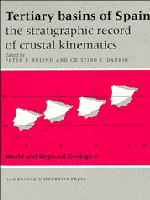Book contents
- Frontmatter
- Contents
- List of contributors
- Preface
- Dedication to Professor Oriol Riba IArderiu
- Memorial, Etienne Moissenet 1941–1994
- PART G GENERAL
- PART E EAST
- PART W WEST
- PART C CENTRE
- PART S SOUTH
- S1 The Betic Neogene basins: introduction
- S2 Neogene palaeogeography of the Betic Cordillera: an attempt at reconstruction
- S3 Depositional model of the Guadalquivir – Gulf of Cadiz Tertiary basin
- S4 Late Neogene depositional sequences in the foreland basin of Guadalquivir (SW Spain)
- S5 Miocene basins of the eastern Prebetic Zone: some tectono sedimentary aspects
- S6 Stratigraphic architecture of the Neogene basins in the central sector of the Betic Cordillera (Spain): tectonic control and base-level changes
- S7 Pliocene–Pleistocene continental infilling of the Granada and Guadix basins (Betic Cordillera, Spain): the influence of allocyclic and autocyclic processes on the resultant stratigraphic organization
- S8 Late Neogene basins evolving in the Eastern Betic transcurrent fault zone: an illustrated review
- S9 Tectonic signals in the Messinian stratigraphy of the Sorbas basin (Almeria, SE Spaín)
- S10 Basinwide interpretation of seismic data in the Alborán Sea
- Index
S4 - Late Neogene depositional sequences in the foreland basin of Guadalquivir (SW Spain)
Published online by Cambridge University Press: 04 August 2010
- Frontmatter
- Contents
- List of contributors
- Preface
- Dedication to Professor Oriol Riba IArderiu
- Memorial, Etienne Moissenet 1941–1994
- PART G GENERAL
- PART E EAST
- PART W WEST
- PART C CENTRE
- PART S SOUTH
- S1 The Betic Neogene basins: introduction
- S2 Neogene palaeogeography of the Betic Cordillera: an attempt at reconstruction
- S3 Depositional model of the Guadalquivir – Gulf of Cadiz Tertiary basin
- S4 Late Neogene depositional sequences in the foreland basin of Guadalquivir (SW Spain)
- S5 Miocene basins of the eastern Prebetic Zone: some tectono sedimentary aspects
- S6 Stratigraphic architecture of the Neogene basins in the central sector of the Betic Cordillera (Spain): tectonic control and base-level changes
- S7 Pliocene–Pleistocene continental infilling of the Granada and Guadix basins (Betic Cordillera, Spain): the influence of allocyclic and autocyclic processes on the resultant stratigraphic organization
- S8 Late Neogene basins evolving in the Eastern Betic transcurrent fault zone: an illustrated review
- S9 Tectonic signals in the Messinian stratigraphy of the Sorbas basin (Almeria, SE Spaín)
- S10 Basinwide interpretation of seismic data in the Alborán Sea
- Index
Summary
Abstract
This chapter presents a reconstruction of the geometry of the Guadalquivir Basin based upon the spatial position and morphology of isochronous surfaces defined by means of bio-events (i.e. discontinuities in the palaeontological record) apparent in the associations of calcareous plankton. It is possible to interpret the depositional history of the basin and to define five depositional sequences to correlate with cycles of global sea-level change.
Introduction
The Guadalquivir Basin is an ENE–WSW-elongated depression filled with Neogene sediments that crop out more than 800 m above sea level at the far eastern end. The topographic surface descends gradually to the west until it reaches the present coast of the Gulf of Cádiz. Sedimentation continues today below sea level in the Gulf of Cádiz.
The Guadalquivir basin separates an emergent foreland made up of Palaeozoic and Mesozoic rocks (the Variscian massif of the Spanish Meseta) to the North and the Betic Cordillera with Mesozoic and Cainozoic rocks to the South (Fig. 1). The Betic Cordillera (also referred to as the Betics) in the southern Iberian peninsula and the Rif in north Africa forms the westernmost major structure of Alpine age. The last Alpine deformation occurred during Serravallian and Early Tortonian times and several ‘postorogenic’ basins have developed under tectonic control of the major structural patterns of the Betics.
- Type
- Chapter
- Information
- Tertiary Basins of SpainThe Stratigraphic Record of Crustal Kinematics, pp. 339 - 345Publisher: Cambridge University PressPrint publication year: 1996
- 34
- Cited by

